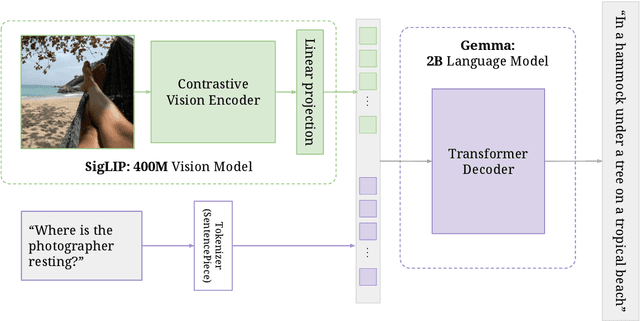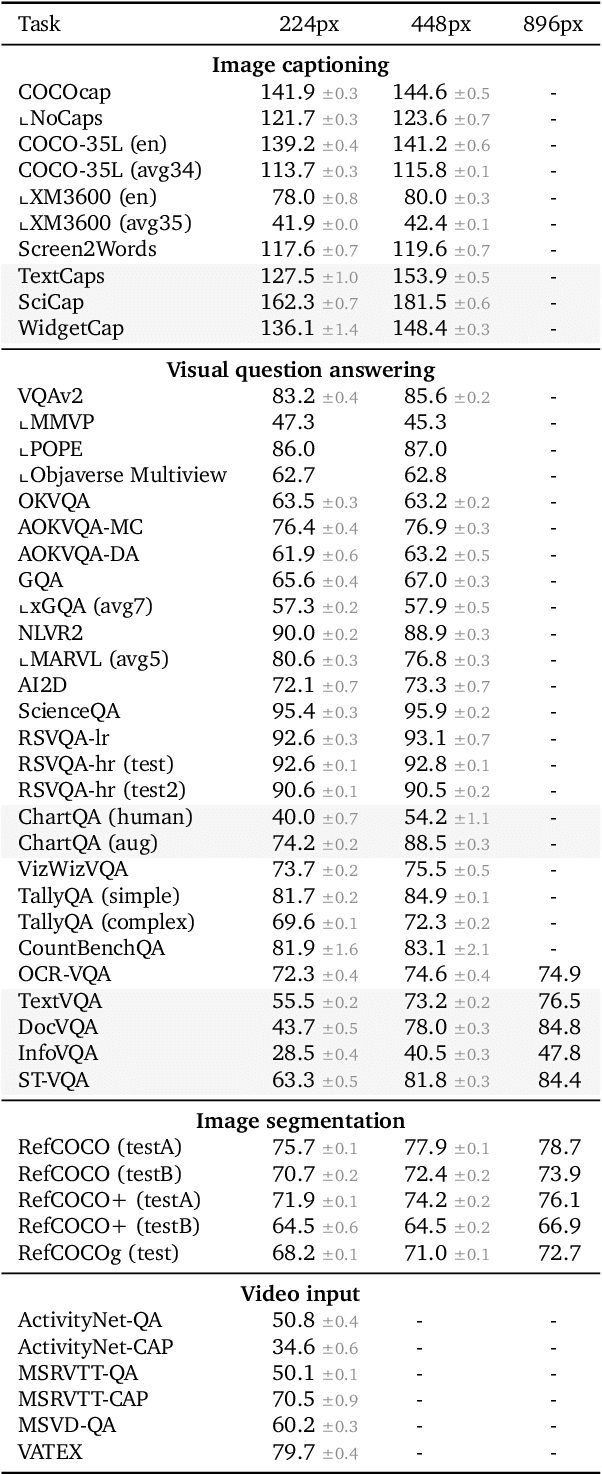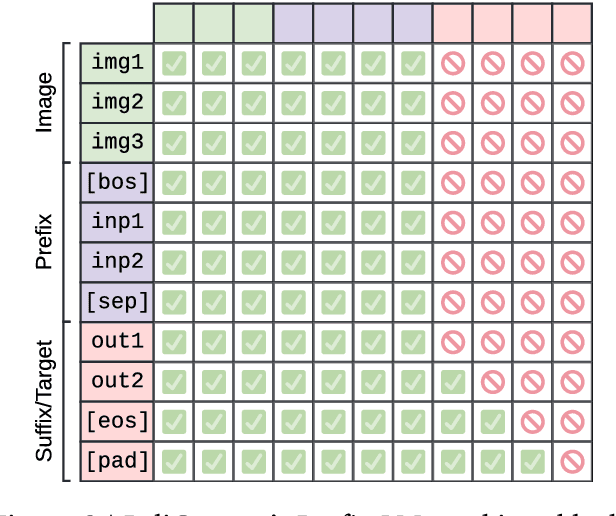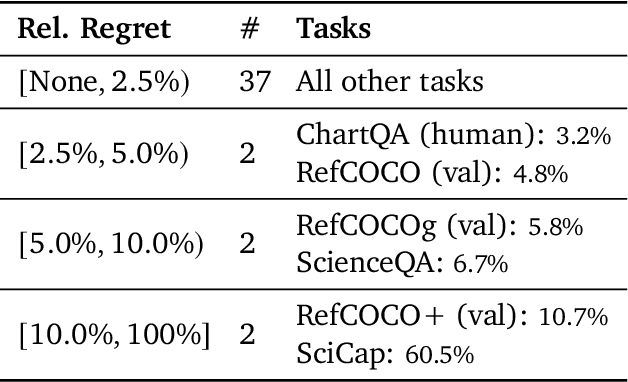Xiaohua Zhai
Zero-shot Autonomous Microscopy for Scalable and Intelligent Characterization of 2D Materials
Apr 14, 2025Abstract:Characterization of atomic-scale materials traditionally requires human experts with months to years of specialized training. Even for trained human operators, accurate and reliable characterization remains challenging when examining newly discovered materials such as two-dimensional (2D) structures. This bottleneck drives demand for fully autonomous experimentation systems capable of comprehending research objectives without requiring large training datasets. In this work, we present ATOMIC (Autonomous Technology for Optical Microscopy & Intelligent Characterization), an end-to-end framework that integrates foundation models to enable fully autonomous, zero-shot characterization of 2D materials. Our system integrates the vision foundation model (i.e., Segment Anything Model), large language models (i.e., ChatGPT), unsupervised clustering, and topological analysis to automate microscope control, sample scanning, image segmentation, and intelligent analysis through prompt engineering, eliminating the need for additional training. When analyzing typical MoS2 samples, our approach achieves 99.7% segmentation accuracy for single layer identification, which is equivalent to that of human experts. In addition, the integrated model is able to detect grain boundary slits that are challenging to identify with human eyes. Furthermore, the system retains robust accuracy despite variable conditions including defocus, color temperature fluctuations, and exposure variations. It is applicable to a broad spectrum of common 2D materials-including graphene, MoS2, WSe2, SnSe-regardless of whether they were fabricated via chemical vapor deposition or mechanical exfoliation. This work represents the implementation of foundation models to achieve autonomous analysis, establishing a scalable and data-efficient characterization paradigm that fundamentally transforms the approach to nanoscale materials research.
SigLIP 2: Multilingual Vision-Language Encoders with Improved Semantic Understanding, Localization, and Dense Features
Feb 20, 2025Abstract:We introduce SigLIP 2, a family of new multilingual vision-language encoders that build on the success of the original SigLIP. In this second iteration, we extend the original image-text training objective with several prior, independently developed techniques into a unified recipe -- this includes captioning-based pretraining, self-supervised losses (self-distillation, masked prediction) and online data curation. With these changes, SigLIP 2 models outperform their SigLIP counterparts at all model scales in core capabilities, including zero-shot classification, image-text retrieval, and transfer performance when extracting visual representations for Vision-Language Models (VLMs). Furthermore, the new training recipe leads to significant improvements on localization and dense prediction tasks. We also train variants which support multiple resolutions and preserve the input's native aspect ratio. Finally, we train on a more diverse data-mixture that includes de-biasing techniques, leading to much better multilingual understanding and improved fairness. To allow users to trade off inference cost with performance, we release model checkpoints at four sizes: ViT-B (86M), L (303M), So400m (400M), and g (1B).
Harnessing Language's Fractal Geometry with Recursive Inference Scaling
Feb 11, 2025Abstract:Recent research in language modeling reveals two scaling effects: the well-known improvement from increased training compute, and a lesser-known boost from applying more sophisticated or computationally intensive inference methods. Inspired by recent findings on the fractal geometry of language, we introduce Recursive INference Scaling (RINS) as a complementary, plug-in recipe for scaling inference time. For a given fixed model architecture and training compute budget, RINS substantially improves language modeling performance. It also generalizes beyond pure language tasks, delivering gains in multimodal systems, including a +2% improvement in 0-shot ImageNet accuracy for SigLIP-B/16. Additionally, by deriving data scaling laws, we show that RINS improves both the asymptotic performance limits and the scaling exponents. These advantages are maintained even when compared to state-of-the-art recursive techniques like the "repeat-all-over" (RAO) strategy in Mobile LLM. Finally, stochastic RINS not only can enhance performance further but also provides the flexibility to optionally forgo increased inference computation at test time with minimal performance degradation.
Scaling Pre-training to One Hundred Billion Data for Vision Language Models
Feb 11, 2025Abstract:We provide an empirical investigation of the potential of pre-training vision-language models on an unprecedented scale: 100 billion examples. We find that model performance tends to saturate at this scale on many common Western-centric classification and retrieval benchmarks, such as COCO Captions. Nevertheless, tasks of cultural diversity achieve more substantial gains from the 100-billion scale web data, thanks to its coverage of long-tail concepts. Furthermore, we analyze the model's multilinguality and show gains in low-resource languages as well. In addition, we observe that reducing the size of the pretraining dataset via quality filters like using CLIP, typically used to enhance performance, may inadvertently reduce the cultural diversity represented even in large-scale datasets. Our results highlight that while traditional benchmarks may not benefit significantly from scaling noisy, raw web data to 100 billion examples, this data scale is vital for building truly inclusive multimodal systems.
PaliGemma 2: A Family of Versatile VLMs for Transfer
Dec 04, 2024



Abstract:PaliGemma 2 is an upgrade of the PaliGemma open Vision-Language Model (VLM) based on the Gemma 2 family of language models. We combine the SigLIP-So400m vision encoder that was also used by PaliGemma with the whole range of Gemma 2 models, from the 2B one all the way up to the 27B model. We train these models at three resolutions (224px, 448px, and 896px) in multiple stages to equip them with broad knowledge for transfer via fine-tuning. The resulting family of base models covering different model sizes and resolutions allows us to investigate factors impacting transfer performance (such as learning rate) and to analyze the interplay between the type of task, model size, and resolution. We further increase the number and breadth of transfer tasks beyond the scope of PaliGemma including different OCR-related tasks such as table structure recognition, molecular structure recognition, music score recognition, as well as long fine-grained captioning and radiography report generation, on which PaliGemma 2 obtains state-of-the-art results.
PaliGemma: A versatile 3B VLM for transfer
Jul 10, 2024



Abstract:PaliGemma is an open Vision-Language Model (VLM) that is based on the SigLIP-So400m vision encoder and the Gemma-2B language model. It is trained to be a versatile and broadly knowledgeable base model that is effective to transfer. It achieves strong performance on a wide variety of open-world tasks. We evaluate PaliGemma on almost 40 diverse tasks including standard VLM benchmarks, but also more specialized tasks such as remote-sensing and segmentation.
Toward a Diffusion-Based Generalist for Dense Vision Tasks
Jun 29, 2024



Abstract:Building generalized models that can solve many computer vision tasks simultaneously is an intriguing direction. Recent works have shown image itself can be used as a natural interface for general-purpose visual perception and demonstrated inspiring results. In this paper, we explore diffusion-based vision generalists, where we unify different types of dense prediction tasks as conditional image generation and re-purpose pre-trained diffusion models for it. However, directly applying off-the-shelf latent diffusion models leads to a quantization issue. Thus, we propose to perform diffusion in pixel space and provide a recipe for finetuning pre-trained text-to-image diffusion models for dense vision tasks. In experiments, we evaluate our method on four different types of tasks and show competitive performance to the other vision generalists.
No Filter: Cultural and Socioeconomic Diversityin Contrastive Vision-Language Models
May 22, 2024Abstract:We study cultural and socioeconomic diversity in contrastive vision-language models (VLMs). Using a broad range of benchmark datasets and evaluation metrics, we bring to attention several important findings. First, the common filtering of training data to English image-text pairs disadvantages communities of lower socioeconomic status and negatively impacts cultural understanding. Notably, this performance gap is not captured by -- and even at odds with -- the currently popular evaluation metrics derived from the Western-centric ImageNet and COCO datasets. Second, pretraining with global, unfiltered data before fine-tuning on English content can improve cultural understanding without sacrificing performance on said popular benchmarks. Third, we introduce the task of geo-localization as a novel evaluation metric to assess cultural diversity in VLMs. Our work underscores the value of using diverse data to create more inclusive multimodal systems and lays the groundwork for developing VLMs that better represent global perspectives.
LocCa: Visual Pretraining with Location-aware Captioners
Mar 28, 2024



Abstract:Image captioning has been shown as an effective pretraining method similar to contrastive pretraining. However, the incorporation of location-aware information into visual pretraining remains an area with limited research. In this paper, we propose a simple visual pretraining method with location-aware captioners (LocCa). LocCa uses a simple image captioner task interface, to teach a model to read out rich information, i.e. bounding box coordinates, and captions, conditioned on the image pixel input. Thanks to the multitask capabilities of an encoder-decoder architecture, we show that an image captioner can easily handle multiple tasks during pretraining. Our experiments demonstrate that LocCa outperforms standard captioners significantly on localization downstream tasks while maintaining comparable performance on holistic tasks.
CLIP the Bias: How Useful is Balancing Data in Multimodal Learning?
Mar 07, 2024



Abstract:We study the effectiveness of data-balancing for mitigating biases in contrastive language-image pretraining (CLIP), identifying areas of strength and limitation. First, we reaffirm prior conclusions that CLIP models can inadvertently absorb societal stereotypes. To counter this, we present a novel algorithm, called Multi-Modal Moment Matching (M4), designed to reduce both representation and association biases (i.e. in first- and second-order statistics) in multimodal data. We use M4 to conduct an in-depth analysis taking into account various factors, such as the model, representation, and data size. Our study also explores the dynamic nature of how CLIP learns and unlearns biases. In particular, we find that fine-tuning is effective in countering representation biases, though its impact diminishes for association biases. Also, data balancing has a mixed impact on quality: it tends to improve classification but can hurt retrieval. Interestingly, data and architectural improvements seem to mitigate the negative impact of data balancing on performance; e.g. applying M4 to SigLIP-B/16 with data quality filters improves COCO image-to-text retrieval @5 from 86% (without data balancing) to 87% and ImageNet 0-shot classification from 77% to 77.5%! Finally, we conclude with recommendations for improving the efficacy of data balancing in multimodal systems.
* 32 pages, 20 figures, 7 tables
 Add to Chrome
Add to Chrome Add to Firefox
Add to Firefox Add to Edge
Add to Edge